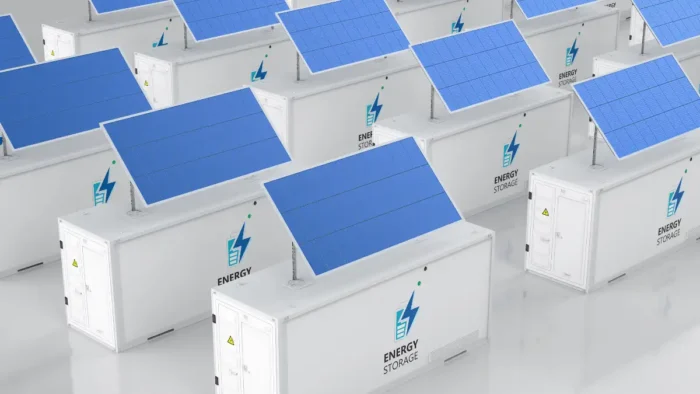How much chance do you have to succeed as an entrepreneur? What are the chances your small business to succeed? How many costs will you have to reach success? What will be the opportunity costs for you? These are important questions about the probability of success and your entrepreneurial career.
Answering them would provide very important information about your path to success. You, as an entrepreneur, will have a much better chance to respond to all possible challenges you will have on your entrepreneurial journey.
Because of that, I would like to talk about how you can work on increasing the probability of your business’s success. What you will find in this article will give you a clear roadmap to your success.
1. Define What Success Means for You
You must define what success means for you as the first step here. This means finding all important elements with business potential energy.
For example, your systems, processes, procedures, and checklists enable execution in your company. The execution is something that brings the results, regardless if the results will be success or failure. So, the way how you systematize your business is one element with the specific business potential energy.
Implement consistent processes inside your company
Consistent processes inside your company will impact your probability of success. If these processes execute right, they will bring result in better product quality, fewer costs, more customers, and so on. All of these bring more chances for your business success.
An example would be someone like Tidewater Roofing, for whom the checklist of onboarding a customer to the final cleanup is a 10-pointer list and is to be followed under a specific period of time to define the best possible success story for that customer so that they can define it as a customer success story which can bring them more word-of-mouth customers.
Start with elements with business potential energy
You must start with the elements that have business potential energy inside your small business or startup. These elements are ones that also we can call business success enablers.
Remember that your goal is to increase the probability of success of your small business.
One important thing you will need to do at this stage is to make a list of all elements inside your business that have business potential energy. These elements will define what success means for your business.
2. How Your Processes Participate in Your Success?
As you already know, your business processes are something that can bring a win-or-lose situation to your company. For example, your production process is a process that creates value for your customers. The mistakes in the process will generate products of lower quality. So, it is an important process when you work on improving your probability of business success.
Related: 10 Reasons Being An Entrepreneur Is Better Than Employment
Types of processes
As you already know, you have two types of processes:
- processes that directly participate in the creation and delivery of the value to the customers, and
- the second processes are those supporting processes for your main processes.
Both processes will play an important role in ensuring your business’s success. Because of that, you will need to define them and integrate them inside your success chain.
Define three critical elements of each of your process
In this step, for each of your main processes, you need to identify three critical things:
- Input elements of the process
- Subprocesses inside the primary process and their relations and
- Desired outputs – the reality of success or what you want to achieve as the outcome of each of your marketing processes.

In such a way, you can come to the mathematical description of your processes where your outcome Y is equal to the function of inputs X. This is the basis of modeling how you can achieve success and increase the probability of success.
Risk factors that will impact the success rate
But, it is not enough. On the first view, it is OK, but besides inputs and the subprocesses, other external factors that most times will be risk factors will impact your outcome.
This is because you are not working in a vacuum, and the conditions surrounding you will affect your outcomes. So what are the external factors? Well, they are mostly things that are out of your control. You can do your best to mitigate them, but some things will just be a part of the job.
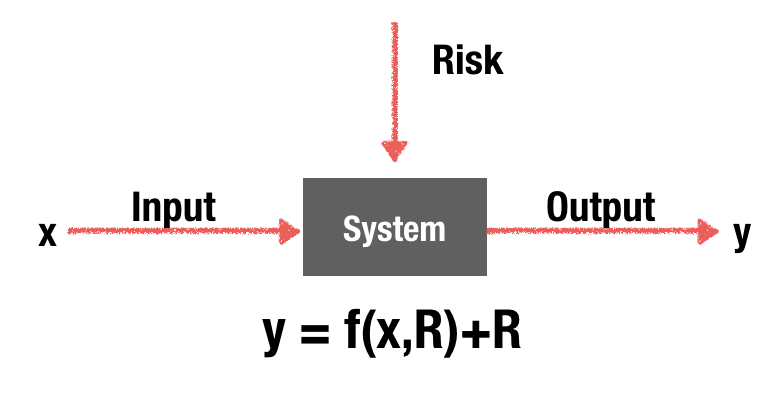
How to measure risk factors?
The often asked question is how you can measure the business risk. Is there a unit of measure for the risk? Most companies make a classification of the risk as high, medium, and low risk. Some use a scale from 1 to 5, where 1 is the lowest risk while 5 is the highest risk.
If you use a systems approach, you can measure anything. You need to understand that organization is a system composed of many other subsystems, processes, procedures, etc. All of them are in place to help you achieve a specific goal. Each system, process, or procedure has some inputs into them, activities inside them, and outputs or results from them.
When you look at your business and its elements in such a way, you can easily see that you have input variables – x, a process in which you manipulate input variables – f(x) to produce the right output – y. In such a case, the simple equation will be the following:
y = f(x)
If you change input parameters and some procedures inside your processes that manipulate with inputs, you will have different results.
External and internal risk factors
But, the organization operates in highly uncertain environments. Such an environment produces a substantial level of risk. So, we need to include the risk factors in this equation.
As you can see, there are two risk factors:
- The first one is environmental or external risk factors. For example, a competitor’s actions are something that can be part of environmental risk factors. Probably you will ask how you will know what the competitors will do. But, again, you already have tools you can use to predict and quantify these things using the game theory as a part of operational research.
- The second risk factor is Input variable risk factors. There will always be a risk related to input indicators. For example, late delivery can cause a problem for the whole system. Or, the price of the raw materials and supplies can vary. Again, you already have a tool to quantify, measure, and analyze these things using ranges. For example, Monte Carlo analysis can be used to calculate risk possibilities from the data.
What will be the external risks for the innovation process? Competition, customers, political factors, national economy, and many other factors can be considered when we talk about managing risks.
Related: 4 Steps Business Idea Generation Process in Entrepreneurship
What will be the risks related to inputs in the innovation process? Here we can talk about the quality of business ideas and the possibility of selecting the wrong or riskiest idea for innovation. But, having the right ideas selection process in place will decrease possible risk.
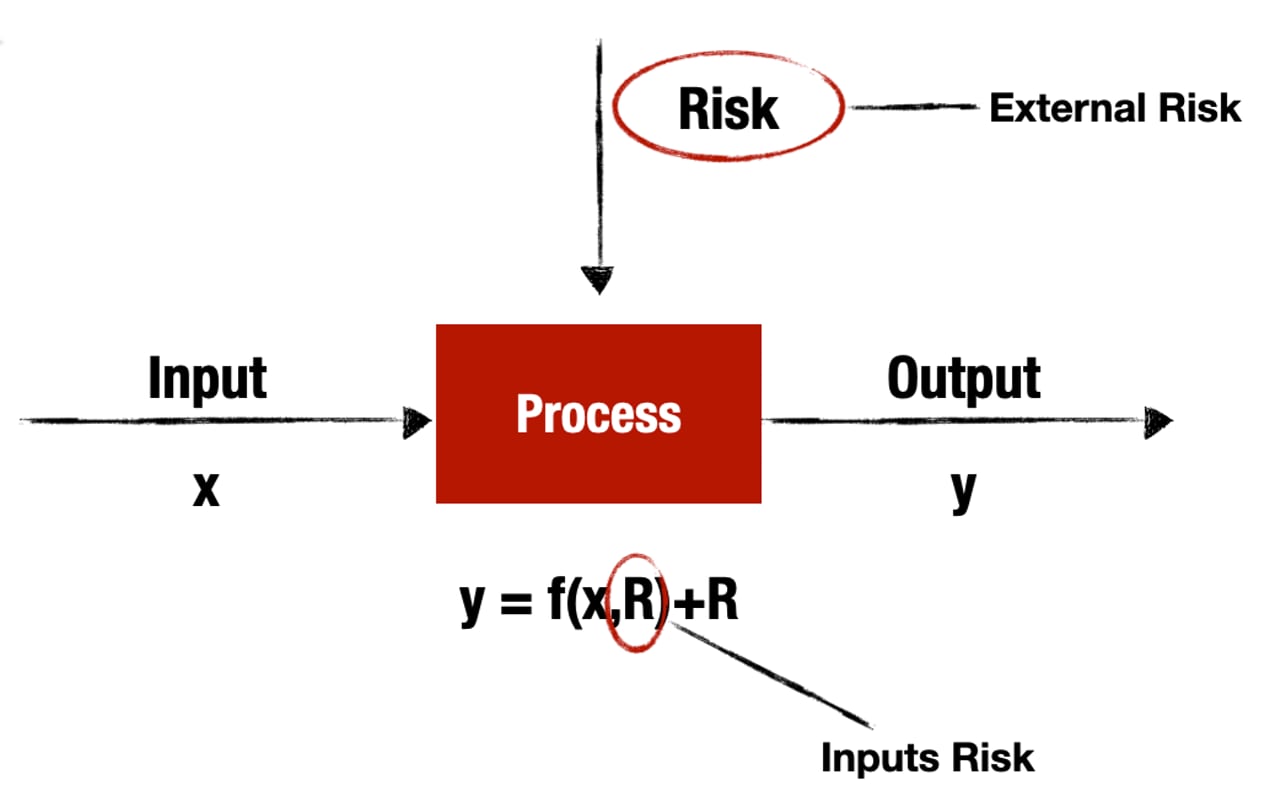
3. Develop Key Performance Indicators (KPIs)
I have seen many small businesses in their everyday operations use the wrong measures. They have enormous problems because they focus their attention on the wrong measures. In such a way, they make wrong decisions, and many of their action steps become failures.
It is vital for you to find clear indicators you will analyze and test regularly. As a first step, you should recognize Key Performance Areas (KPA), i.e., your company’s key goals. You should define the next KPIs per value for each KPA. Finally, you can measure every KPI (quantitatively), or you can assess them (qualitatively) by one or more concrete Performance Indicators (PIs). We can present the three levels of analysis as a pyramid where at the top are the KPAs and at the bottom the concrete Performance Indicators that you can use to assess the performance value.
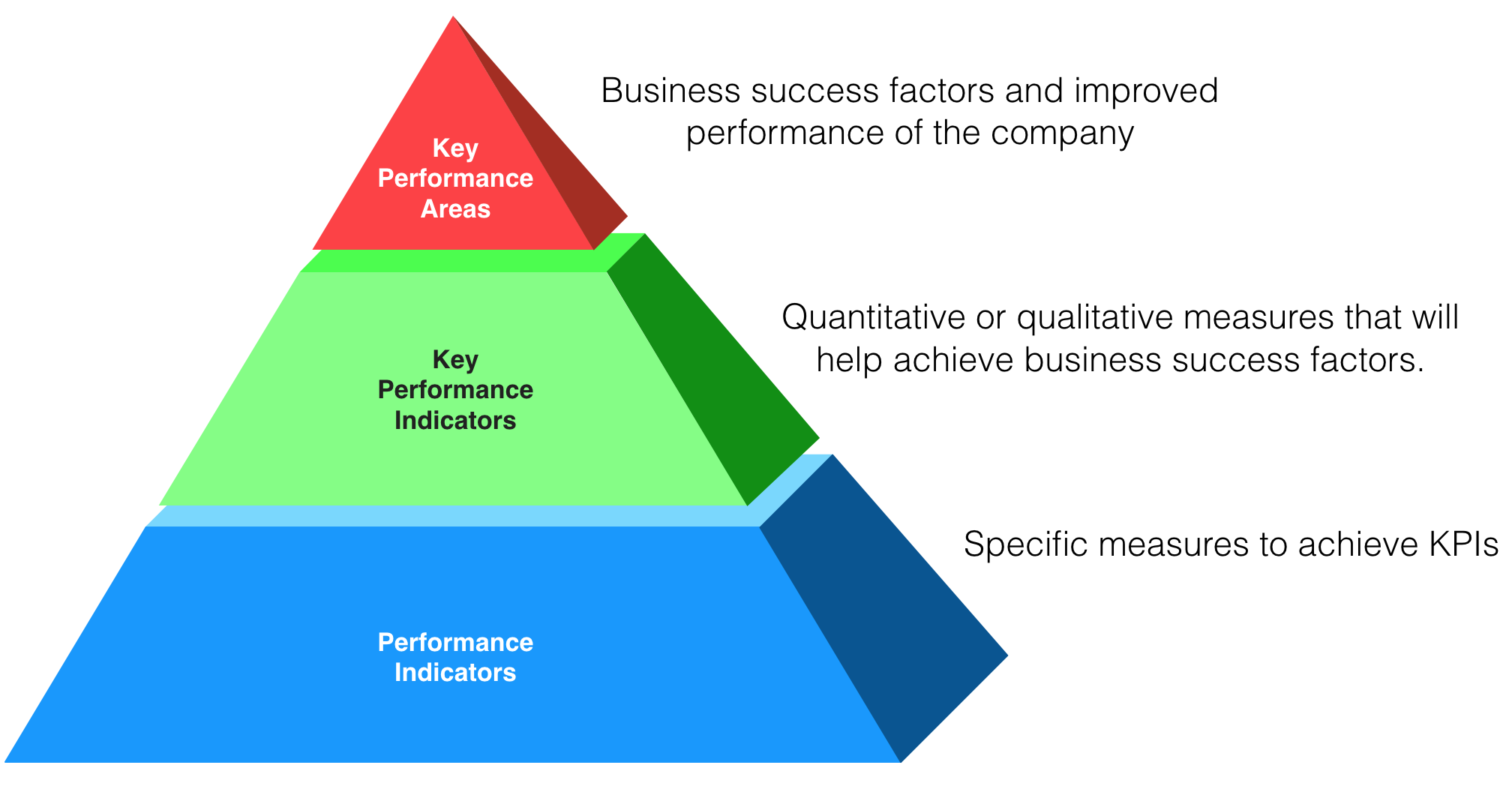
Key Performance Areas (KPA)
KPAs are areas for the company’s success factors and improved performance of the whole company. You can assess KPAs by assessing one or more concrete KPIs related to this specific area. This hierarchy will enable you to have a more transparent and aggregated view of many KPIs, especially when your company has complex structures and heterogeneous business processes.
The first step for you here is to define goal areas and success factors on the KPA level. Then you can set up and refine these goals and elements by different KPIs.
Key Performance Indicators
Key performance indicators, known as KPIs, are quantitative or qualitative measures that should show your company’s business success factors and strategic performance.
Related: 31 Startup KPIs and Metrics to Measure with Examples
They measure the impact of a company’s actions on its performance, allowing management to gauge whether the business is growing in the right direction. Key performance indicators also provide a baseline for evaluating company performance over time. KPIs may include:
- Operating revenue (in dollars)
- Operating profit (in dollars)
- Net income (in dollars)
- Dividends per share
- Total assets
- Market capitalization
- Revenue per employee
- Profit per employee
- Profit margin
- Sales growth, etc.
Performance Indicators
More than one KPI is related to the same success factor or Performance Indicators (PI). In such a way, you can evaluate different areas of interest to achieve a specific goal.
The PIs are measures that refer to a particular period during which you will collect, measure and assess their values. The definition of what they are and how you can measure or evaluate them does not change often. You must define a specific target, the period of validation, measurement units and the description, how to assess/measure, and how and where you will collect the data for each PI.
4. What is the probability of success?
A probability of success, or better said, your business success measures the likelihood that you will get the desired outcomes based on what you are doing as a business. With the probability of success, you can calculate the chances you will get to your desired outcomes.
For example, if you want to increase your profit by 10% at least next year, you have a 50% probability of success and a 50% chance of achieving your goal. But, this is said most simply. The reality is not simple. You will have many factors or what you do that will impact this probability. For example, one factor can be to work on decreasing your costs. This goal will need many tasks. So, you will need to calculate the conditional probability for this example.
But, let’s continue with the explanation of the probability of success. If you do something that must result in any of n equal probabilities, and if s is the number of success achieved (desired situations) and f is the number of failings, the probability of success will be p = s/(s+f).
If we look contrary, the probability of failure will be q = f/(s+f), or q = 1 – p.
5. Use systems to measure your probability of success
Now, when you design your systems and define all the important KPIs, you can develop another system in your company. This system will measure the probability of success.
If you have already designed your processes, you can see that they depend on each other. The outcome from one process is the input in the next process.
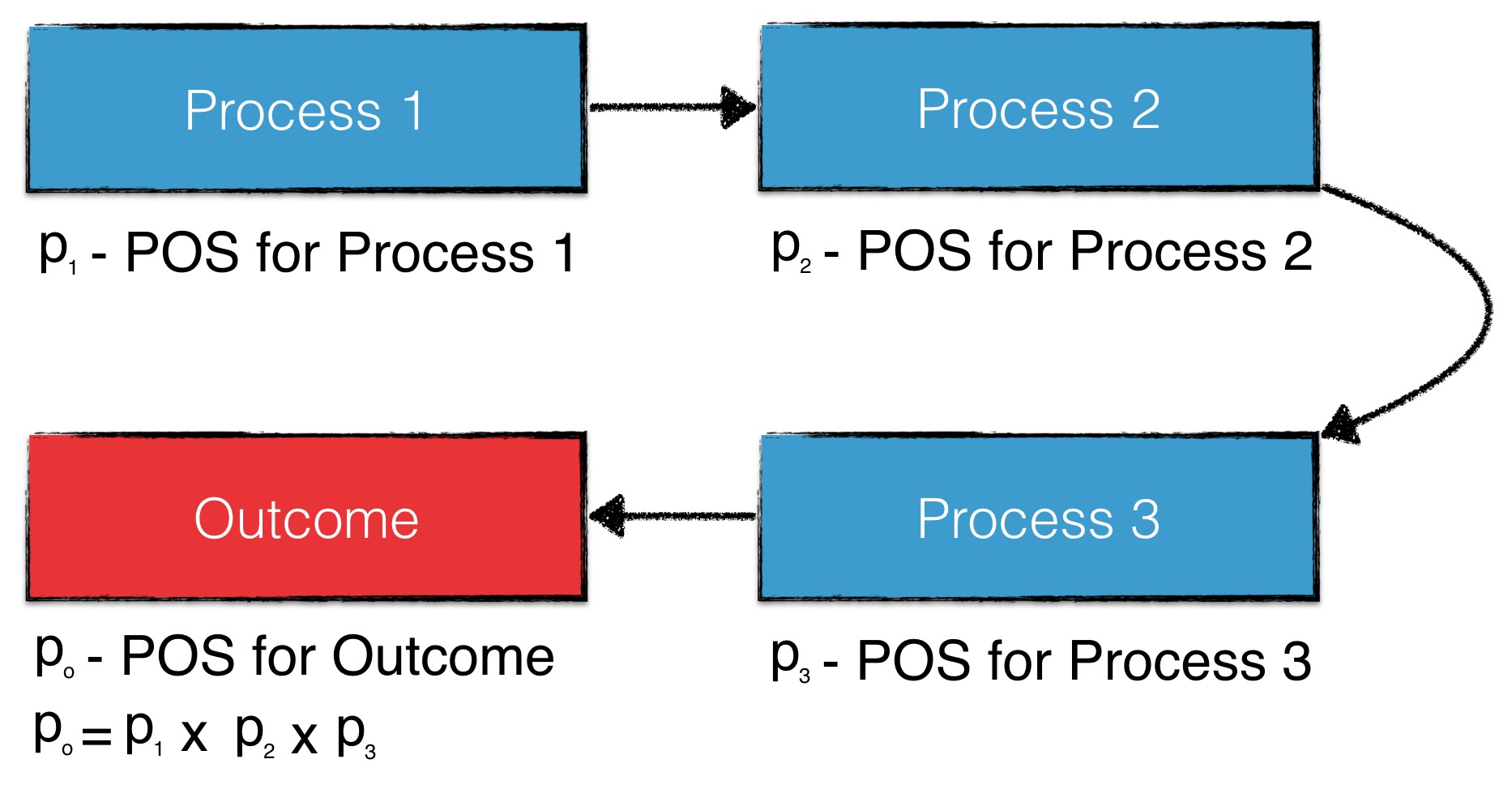
As you can see, all processes have their own probability of success (POS), and you can calculate the probability of success of the outcome with the multiplication of POSs for all processes that participate in the result’s creation.
Let’s look at one simple example.
Three independent operations perform sequentially for the production of a single product. The probability of performing any of the first-time operations without defects is p1 = 0.90, p2 = 0.95 and p3 = 0.80, for each of the processes, respectively. This means that there are 90% chances that the first operation will do the work without defects, 95% for the second operation, and 80% for the third operation.
After the completion of all three operations, the probability of quality products as the outcome will be (0.90) x (0.95) x (0.80) = 0.684, or 64.8% of the products will be classified as quality products.
This is only one simple example of how you can use a systematic approach to measure the probability of success of your processes. Your reality will be much more complex because the processes will have a more complex structure. However, you can see what you need to do in this step.
The most important outcome of this step is to have defined processes, procedures, and instructions on measuring your probability of success.
6. Use experiments based on trial and error
Now, because you have developed all the critical things in the previous five steps, it is time to start working on your business improvements, increasing your overall probability of success.
Let’s continue with the same example of three operations in the previous step.
By improving the quality of the operations, you have improved the probability of success for any of the defect-free operations at the following levels: p1 = 0.94, p2 = 0.96, and p3 = 0.88. After the completion of all three operations, the probability of quality products will be (0.94) x (0.96) x (0.88) = 0.794, or 79.4% will be classified as quality products. As you can see, we have improved our production capacity for almost 15% more quality products from the first time.
Now, the question is how we can work on improvements. The answer is simple, and we already cover this when we talk about how each process takes part in creating success as the outcome. So, you need to design experiments and use the trial-and-error method.
Because we already have the relation between input, the process itself, and the output of each process, we can combine different things as the inputs and tweak our internal processes to see how they will impact the outcomes. Remember that the outcomes of each of your processes will define your probability of success.


